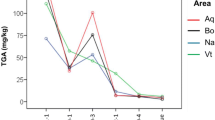Summary
The glycoalkaloid content in 18 potato varieties grown in Oman was measured by HPLC using peel and flesh tissues. The total glycoalkaloid content of the tubers was found to be variety dependent and varied greatly between the 18 varieties. The total glycoalkaloid in the tubers of seven varieties was within the safe limit of ≤200 mg kg− 1 FW recommended for food safety, whereas the remaining 11 varieties exceeded this upper limit. The principal glycoalkaloids α-chaconine and σ-solanine were present in higher concentration in the peel than in the flesh of all varieties with the former being the principal alkaloid in the peel. The flesh of all of the 18 potato varieties contained total glycoalkaloid levels lower than the upper safety limit. The leaves of the 18 potato varieties were also analyzed for glycoalkaloids. The levels of glycoalkaloids in expanding leaves were higher than that of expanded leaves with the exception of six varieties. The principal glycoalkaloid in expanding and expanded leaves was α-chaconine. No correlation was observed between the glycoalkaloids levels of in the leaves and tubers.
Similar content being viewed by others
References
Ahmed, S.S. & K. Müller, 1979. Seasonal changes and the effect of nitrogen- and potash-fertilization on the solanine and a-chaconine content in various parts of the potato plant.Zeitschrift für Pflanzenernährung und Bodenkunde 142: 275–279.
Dale, M.F.B., D.W. Griffiths & H. Bain, 1998. Effect of bruising on the total glycoalkaloid and chlorogenic acid content of potato (Solarium tuberosum) tubers of five cultivars.Journal of the Science of Food and Agriculture 77: 499–505.
Dimenstein, L., N. Lisker, N. Kedar & D. Levy, 1997. Changes in the content of steroidal glycoalkaloids in potato tuber grown in the field and in the greenhouse under different conditions of light, temperature and day length.Physiological and Molecular Plant Pathology 50: 391–402.
Friedman, L. & G.M. McDonald, 1997. Potato glycoalkaloids: Chemistry, analysis, safety, and plant physiology.Critical Reviews in Plant Sciences 16: 55–132.
Friedman, L. & G.M. McDonald, 1999b. Postharvest changes in glycoalkaloid content of potatoes. In: Jackson et al. (Eds), Impact of processing on food safety. Plenum Publishers, New York, pp. 121–143.
Gelder, W.M J. van, 1990. Chemistry, toxicology, and occurrence of steroidal glycoalkaloids: potential contaminants of the potato (Solanum tuberosum L.). In: Rizc, A.F.M. (Ed.), Poisonous Plants Contaminating Edible Plants. CRC Press, Boca Raton, Florida, pp. 117–156.
Gregory, P., 1984. Glycoalkaloid composition of potatoes: diversity and biological implications.American Potato Journal 61: 115–122.
Gregory, P., S.L. Sinden, S.F. Osman, W.M. Tingey & D.A. Chessin, 1981. Glycoalkaloids of wild, tuber-bearingSolanum species.Journal of Agricultural and Food Chemistry 29: 1212–1215.
Hellenas, K.E., C. Branzell, H. Johnsson & P. Slanina, 1995a. High levels of glycoalkaloids in the established Swedish potato variety Magnum Bonum.Journal of the Science of Food and Agriculture 68: 249–255.
Hellenas, K.E., C. Branzell, H. Johnsson & P. Slanina, 1995b. Glycoalkaloid content of early potato varieties.Journal of the Science of Food and Agriculture 67: 125–128.
Jadhav, S.J., A. Kumar & J.K. Chavan, 1991. Glycoalkaloids. In: Salunkhe, D.K., S.S. Kadam & S.J. Jadhav (Eds), Potato: production, processing, and products. CRC Press, Boca Raton, pp. 203–245.
Khan, I.A., M.L. Deadman & K.A. Al-Habsi, 2001. Screening potato varieties for cultivation in arid regions: Effect of planting date on emergence of imported and locally produced seed.Sultan Qaboos University Journal of Scientific Research-Agricultural Sciences 6: 41–46.
Khan, I. A., M. L. Deadman & K. A. Al-Habsi, 2002. Screening potato varieties for cultivation in arid regions: Effect of planting dates on yield potential.Sultan Qaboos University Journal of Scientific Research-Agricultural Sciences 7: 53–57.
Kozukue, N., E. Kozukue & S. Mizuno, 1987. Glycoalkaloids in potato plants and tubers.HortScience 22: 294–296.
Maga, J.A., 1994. Glycoalkaloids in Solanaceae.Food Reviews International 10: 385–418.
Morris, S.C. & J.B. Petermann, 1985. Genetic and environmental effects on levels of glycoalkaloids in cultivars of potato (Solanum tuberosum L.).Food Chemistry 18: 271–282.
Morris, S.C. & T.H. Lee, 1984. The toxicity and teratogenicity of Solanaceae glycoalkaloids, particularly those of the potato (Solanum tuberosum).Food Technology in Australia 36: 118–124.
Nitithamyong, A., J.H. Vonelbe, R.M. Wheeler & T.W. Tibbitts, 1999. Glycoalkaloids in potato tubers grown under controlled environments.American Journal of Potato Research 76: 337–343.
Percival, G.C. & G.R. Dixon, 1994. Glycoalkaloid concentration of potato tubers following continuous illumination.Journal of the Science of Food and Agriculture 66: 139–144.
Percival, G.C. & G.R. Dixon, 1997. Glycoalkaloids. In: D=Mello, J.P.F. (Ed.), Handbook of plant and fungal toxicants. CRC Press, Inc., New York, pp. 19–35.
Roddick, J.G. & G. Melchers, 1985. Steroidal glycoalkaloid content of potato, tomato, and their somatic hybrids.Theoretical and Applied Genetics 70: 655–660.
Roddick, J.G., 1989. The acetylcholinesterase-inhibitory activity of steroidal glycoalkaloids and their aglycones.Phytochemistry 28: 2631–2634.
Roddick, J.G., 1996. Steroidal glycoalkaloids: nature and consequences of bioactivity. In: Waller & Yamasaki (Eds), Saponins used in traditional and modern medicine. Plenum Press, New York, pp. 277–295.
Sinden, S.L., L.L. Sanford & R.E. Webb, 1984. Genetic and environmental control of potato glycoalkaloids.American Potato Journal 61: 141–156.
Smith, D.B., J.G. Roddick & J.L. Jones, 1996. Potato glycoalkaloids: some unanswered questions.Trends in Food Science and Technology 7: 126–131.
Sotelo, A. & B. Serrano, 2000. High-performance liquid Chromatographic determination of the glycoalkaloids α-solanine and α-chaconine in 12 commercial varieties of Mexican potato.Journal of Agricultural and Food Chemistry 48: 2472–2475.
Uppal, D.S., 1987. Varietal and environmental effect on the glycoalkaloid content of potatoSolanum tuberosum L.).Plant Foods for Human Nutrition 37: 333–340.
Veilleux, R.E., M.M. Paz & D. Levy, 1997. Potato germplasm development for warm climates: genetic enhancement of tolerance to heat stress.Euphytica 98: 83–92.
Author information
Authors and Affiliations
Corresponding author
Rights and permissions
About this article
Cite this article
Eltayeb, E.A., Al-Sinani, S.S. & Khan, I.A. Determination of the glycoalkaloids α-solanine and α-chaconine levels in 18 varieties of potato (Solarium tuberosum L.) grown in Oman. Potato Res 46, 57–66 (2003). https://doi.org/10.1007/BF02736103
Accepted:
Issue Date:
DOI: https://doi.org/10.1007/BF02736103




